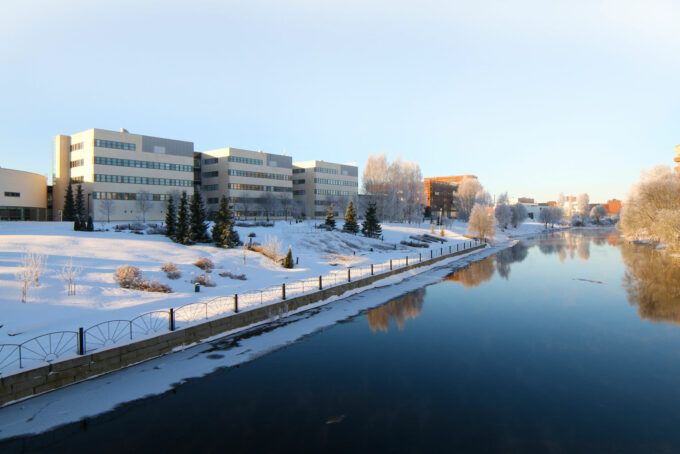
Digital Open Science Tools: How to Achieve More Openness Through an Inclusive Design
Through their responsive design, digital Open Science tools promise to enable and simplify collaboration across disciplines, world regions and language groups. But how inclusive are these tools actually globally? Global means that they are equally open in low and middle income countries. Louise Bezuidenhout and Jo Havemann have examined 242 Open Science tools in terms of their geolocalisation, conditions and financing models. They have identified their weaknesses in terms of geographical openness and are developing ideas on how to make the Open Science ecosystem even more inclusive and a truly "unlimited digital commons".
we were talking with Louise Bezuidenhout and Jo Havemann
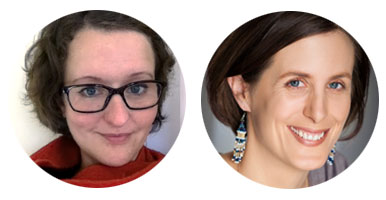
In their project “The varying openness of digital open science tools” Louise Bezuidenhout and Jo Havemann analyse the actual accessibility of such tools. They are often designed for a specific community, depending on the interests of the funding institutes. From the point of view of western industrialised countries, they are thus usually sufficiently open. In fact, however, they present researchers in African countries, for example, with major challenges: Does an adequate internet connection exist there? Are the programmes also available in the respective language? Or are they even hidden behind a paywall?
Skip to PDF contentIn this interview, the two authors reveal possible solutions and concrete starting points. They also give tips on how libraries can contribute. They suggest: In order to make the future Open Science ecosystem inclusive and operable for researchers in all world regions including Africa, Latin America, Asia and Oceania, those should be actively included in design decision processes.
In your project on the different degrees of geographical openness of digital Open Science tools (DOSTs), you take a closer look at the design of these tools. How did you find this is actually a problem in the first place?
Louise: Both Jo and I work closely with researchers from low- and middle-income countries (LMICs). In our conversations, they regularly raise concerns relating to the digital tools and resources that support modern research. These are often related to issues of paywalls and membership fees – a particular problem for researchers working in countries with weak currencies, under-funded institutions and few research grants. Additional challenges include the unsuitability of certain tools for use in low-bandwidth environments, the lack of linguistic diversity in the digital research landscape as well as the lack of engagement with researchers working in LMICs during the development and roll-out of digital tools and resources.
Over the last three years, I’ve been doing a lot of work with researchers working in countries currently under sanction from the US. There is a lot of anecdotal evidence on social media about certain digital tools being blocked to researchers working in sanctioned countries, but there has been little systematic study of the extent of this issue. We’ve been working hard to gather evidence on this issue of “geoblocking” and to reflect on how the prevalence of this geoblocking affects our understanding of Open Science.
Skip to PDF contentJo and I decided to bring together all of these areas of concern and critically interrogate the digital research ecosystem. We’re both strong advocates for Open Science, and feel that it is important to discuss issues of openness and inclusion from an informed perspective, instead of just assuming that researchers around the globe will have equal access to any tools and resources placed online.
To which Open Science tools are you specifically referring to?
Jo: We looked at tools that are applicable across the research workflow and are specifically developed by organisations and initiatives to serve the Open Science principles. In doing so, we built on the Innovations in Scholarly Communication project by Bianca Kramer and Jeroen Boseman who categorised a range of digital research tools for their applicability in discovery (literature search), analysis, writing, publication, outreach and assessment.
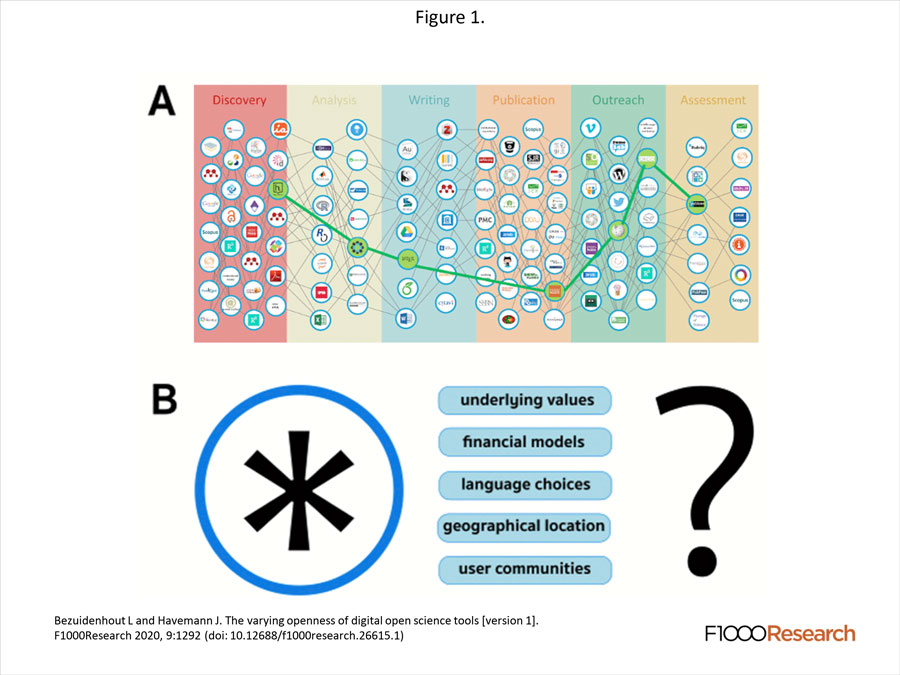
Figure 1. A) Diagram from Kramer & Bosman (2016)13 demonstrating diversity of DOSTs, linkages between tools at different stages of workflow. Green line demonstrates a potential research workflow involving DOSTs. B) Pictogram of a random digital tool representing the tools displayed in 1A with influencing aspects addressed in this paper: underlying values, financial models, language choices, geographical location, user communities. Bezuidenhout L. and Havemann J. The varying openness of digital open science tools [version 1]. F1000Research 2020, 9:1292 (DOI). Image shared under CC-BY 4.0 license.
Sourcing from Joint Roadmap for Open Science Tools (JROST) and by adding tools we use ourselves and are aware of, we compiled a list of 242 digital tools many of which were specifically developed to serve Open Science principles and do so in aspects such as that they facilitate transparency, rapid research result dissemination and fair assessment. To investigate global adaptability of these tools we ask in the paper about the underlying values, financial models, language choices, geolocation and openness to various user communities.
What makes the designs of Open Science tools not inclusive?
Louise: There is a wide range of issues that makes digital Open Science tools less inclusive for certain researcher communities. Most of these can be traced back to design and dissemination decisions made during the evolution of the tools. For instance, if the DOST developers design with their local research community in mind and pilot in the same community, then the design will necessarily reflect the parameters of that community. This means that it will be tailored towards the preferences of that specific user community, and calibrated to the infrastructures that are available in their research environment. This can mean that the tool, while optimally calibrated for a certain user community, is less useful for other research communities, because we have to recognise that research communities (in terms of composition, working practices, research environments and cultures) are highly heterogeneous around the world.
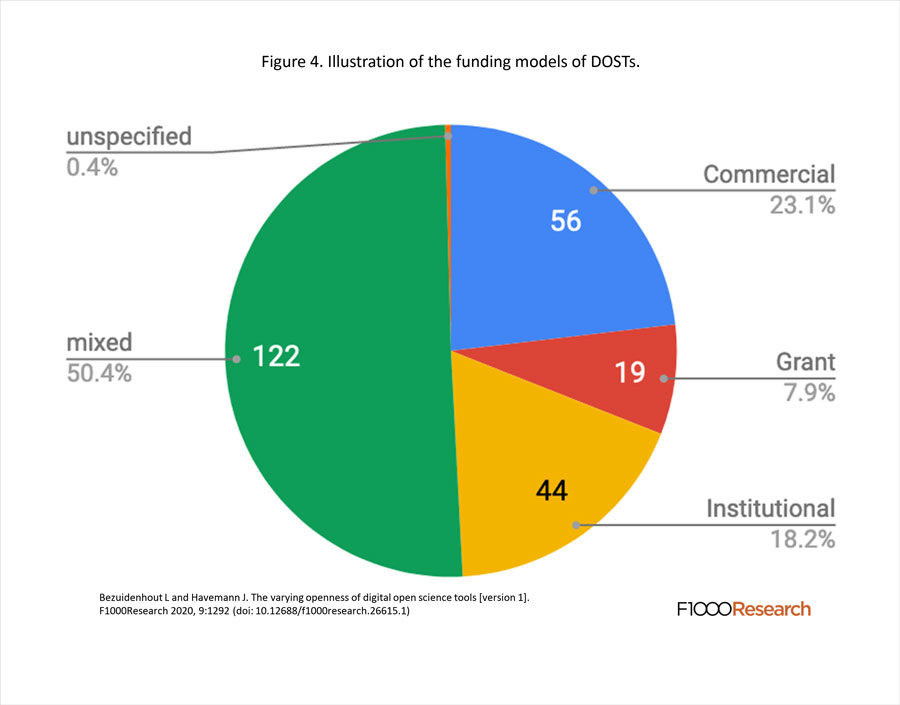
Figure 4. Illustration of the funding models of DOSTs. The funding sources for the respective tools were classified as a) Commercial (n=56, 23.1%); b) Grant (n=19, 7.9%); c) mixed (commercial and grant, n=122, 50.4%), and d) Institutional (n=44, 18.2%). 0.4% of the tools (n=1) had no funding source specified. n=242. Bezuidenhout L. and Havemann J. The varying openness of digital open science tools [version 1]. F1000Research 2020, 9:1292 ( DOI). Image shared under CC-BY 4.0 license.
Another key problem that we identify relates to the funding of DOST development. Because DOSTs are often formed by volunteer communities or start-up entrepreneurs, they rely on a wide range of different funders and often do not have the luxury of choosing where they accept money from. This means that many DOSTs have “strings attached” through their funding. By this I mean that the preferences of the funder – including who has access to the tool – are integrated into the design and dissemination of the DOST. This can have significant implications for the inclusivity of user communities.
How can they be made more inclusive? Where would you start?
Louise: As we advocate in the paper, we feel that there needs to be more critical scrutiny of DOSTs as they are designed and integrated into the Open Science ecosystem. We believe that using models such as Responsible Research and Innovation (RRI) can assist DOST developers from anticipating possible future challenges and pro-actively integrating mitigation strategies into their design decisions.
Jo: Actively invite tech developers and researchers from Africa, Latin America and Asia to participate in design sprints and provide sufficient budgets for these activities to allow people to participate and contribute for example by ensuring that internet is paid for during the event and equipment available locally is functional to enable efficient contributions.
How can we succeed in including geographical groups that have often been ignored up to now? Where do you see concrete starting points?
Louise: I think one of the most important starting points is to have more and extended discussions with researchers in LMICs about these issues. Because they have had the experiences of trying to use the tools, they have detailed opinions about what works and what doesn’t work. Many of them have also found innovative work-arounds to the barriers they encounter in the digital research landscape – either by developing their own tools or by forging different connections or research pathways within the online environment. Increased engagement with these communities and better systematically collected evidence – on both their challenges and solution suggestions – would be of significance to any DOST design.
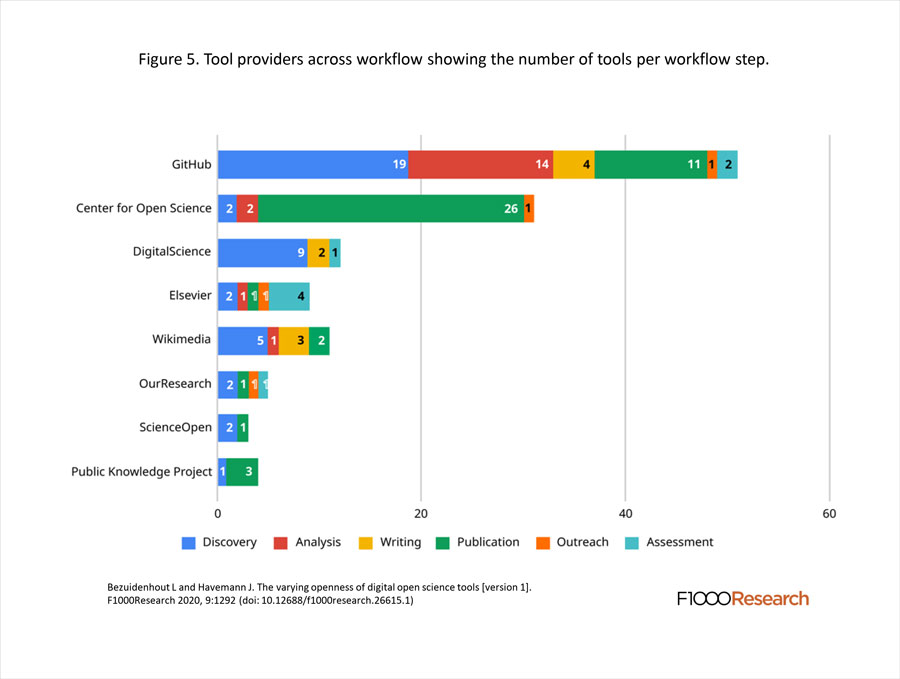
Figure 5. Tool providers across workflow showing the number of tools per workflow step. Bezuidenhout L. and Havemann J. The varying openness of digital open science tools [version 1]. F1000Research 2020, 9:1292 ( DOI). Image shared under CC-BY 4.0 license.
Jo: With AfricArXiv and our partner organisations, we are actively fostering such discussions to occur more widely even across language groups and disciplines. We sensitise platform and service providers on the regional challenges and opportunities to encourage a more inclusive tool design and regional adaptation based on extensive consultations with the respective stakeholders. One bottleneck is limited financial resources but thankfully several initiatives exist to raise awareness and design approaches, such as Invest in Open Infrastructure and the previously mentioned Joint Roadmap for Open Science Tools (JROST).
What can libraries, which often offer or use such Open Science tools themselves, contribute to making Open Science tools even more inclusive geographically?
Louise: I think that libraries – particularly as they move into the role of data stewards and curators – are ideally placed to draw attention to issues of inclusivity in the Open Science landscape. Librarians should critically examine the tools that they recommend to ensure that they are maximally inclusive and open. If they do this then they are in a position to foster inclusive data dissemination on an institutional level by advising researchers to use highly inclusive tools.
Jo: Criteria to consider should also include the level of interoperability, how many and which languages the tool serves – does it allow multilingual submissions, and is it possible to integrate the tool into the existing digital infrastructure of the institutions. It is essential that librarians extensively consult with research staff from many disciplines at their institute to inquire about preferences and requirements of individual researcher’s departments, sometimes set by funders or other scholarly stakeholders.
This might also interest you
- Presentation of “The Varying Openness of Digital Open Science Tools” about the results of the manuscript by Jo Havemann and Louise Bezuidenhout.
- The varying openness of digital open science tools [version 1; peer review: awaiting peer review]. F1000Research 2020, 9:1292.
- The Varying Openness of Digital Open Science Tools (preprint).
- Economic sanctions and academia: Overlooked impact and long-term consequences.
- Open Access: AfricArXiv facilitates knowledge exchange between Africa and Europe.
- Research tools: From A for Altmetrics, B for Bench Work to C for Collaboration .
Dr Louise Bezuidenhout is a researcher at the Institute for Science, Innovation and Society at the University of Oxford. Her work focuses on research systems in low- and middle-income countries and issues of inclusivity with global research communities. Much of her research focuses on issues of access, justice and resource distribution within Open Science.
With a background in Evolution and Developmental Biology, Dr Johanna Havemann is a trainer and consultant in [Open] Science Communication and [digital] Science Project Management. Her work experience covers Non-Governmental Organisations, a science startup and international institutions including the United Nations Environment Programme. With a focus on digital tools for science and her label Access 2 Perspectives, she aims at strengthening global science communication in general – with a regional focus on Africa – through Open Science.
References portaits:
Louise Bezuidenhout: Louise Bezuidenhout©
Jo Havemann: Jo Havemann©
View Comments

Open Science and Organisational Culture: Openness as a Core Value at the ZBW
Open Science has become a central focus of work for the ZBW - Leibniz Information...

